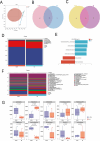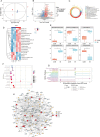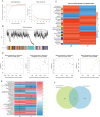Dietary isobutyric acid supplementation improves intestinal mucosal barrier function and meat quality by regulating cecal microbiota and serum metabolites in weaned piglets
- PMID: 40386040
- PMCID: PMC12081365
- DOI: 10.3389/fvets.2025.1565216
Dietary isobutyric acid supplementation improves intestinal mucosal barrier function and meat quality by regulating cecal microbiota and serum metabolites in weaned piglets
Abstract
This study aimed to provide evidence for the effects of isobutyric acid on the intestinal mucosal barrier and gut microbiota in weaned piglets. In this study, 30 piglets were divided into two groups: one group was fed a standard diet (CON group), and the other group was fed a diet supplemented with 0.5% isobutyric acid (IB group) for 21 days. The results showed that isobutyric acid significantly increased (p < 0.05) serum immunity and antioxidant capacity in weaned piglets. In small intestine of piglets, the ratio of villus height to crypt depth was significantly increased (p < 0.05). Administration of isobutyric acid also increased (p < 0.05) the expression of genes related to intestinal mucosal barrier function. Cecal microbiota analysis revealed that isobutyric acid significantly increased (p < 0.05) the abundance of the Eubacterium coprostanoligenes group. Untargeted serum metabolomics analysis indicated that the top three categories of metabolites were lipids and lipid-like molecules, organic acids and derivatives, and organic heterocyclic compounds. Additionally, in longissimus thoracis muscle, isobutyric acid significantly increased (p < 0 0.05) intramuscular fat and triglyceride content compared with the CON group. Overall, isobutyric acid can improve small intestinal mucosal barrier function, and may influence the fat deposition through the regulation of serum metabolites in weaned piglets.
Keywords: gut microbiota; intestinal mucosal barrier function; intramuscular fat; isobutyric acid; serum metabolome; weaned piglets.
Copyright © 2025 Wang, Hou, Cao, Wei, Sun, Ji, Chu, Zhang, Jiang, Shi, Liu, Song and Wen.
Conflict of interest statement
The authors declare that the research was conducted in the absence of any commercial or financial relationships that could be construed as a potential conflict of interest.
Figures








Similar articles
-
Elucidating the modulatory role of dietary hydroxyproline on the integrity and functional performance of the intestinal barrier in early-weaned piglets: A comprehensive analysis of its interplay with the gut microbiota and metabolites.Int Immunopharmacol. 2024 Jun 15;134:112268. doi: 10.1016/j.intimp.2024.112268. Epub 2024 May 16. Int Immunopharmacol. 2024. PMID: 38759371
-
Effects of α-glycerol monolaurate on intestinal morphology, nutrient digestibility, serum profiles, and gut microbiota in weaned piglets.J Anim Sci. 2022 Mar 1;100(3):skac046. doi: 10.1093/jas/skac046. J Anim Sci. 2022. PMID: 35167667 Free PMC article.
-
Dietary emodin alleviates lipopolysaccharide-induced intestinal mucosal barrier injury by regulating gut microbiota in piglets.Anim Nutr. 2023 May 16;14:152-162. doi: 10.1016/j.aninu.2023.05.004. eCollection 2023 Sep. Anim Nutr. 2023. PMID: 37455790 Free PMC article.
-
Dietary Berberine and Ellagic Acid Supplementation Improve Growth Performance and Intestinal Damage by Regulating the Structural Function of Gut Microbiota and SCFAs in Weaned Piglets.Microorganisms. 2023 May 10;11(5):1254. doi: 10.3390/microorganisms11051254. Microorganisms. 2023. PMID: 37317228 Free PMC article.
-
Resveratrol alleviates oxidative stress induced by oxidized soybean oil and improves gut function via changing gut microbiota in weaned piglets.J Anim Sci Biotechnol. 2023 Apr 7;14(1):54. doi: 10.1186/s40104-023-00851-2. J Anim Sci Biotechnol. 2023. PMID: 37029412 Free PMC article.
References
-
- Maito CD, Melo ADB, de Oliveira ACDF, Genova JL, Engracia Filho JR, de Macedo REF, et al. . Simultaneous feeding of calcium butyrate and tannin extract decreased the incidence of diarrhea and proinflammatory markers in weaned piglets. Anim Biosci. (2022) 35:87–95. doi: 10.5713/ab.21.0011, PMID: - DOI - PMC - PubMed
LinkOut - more resources
Full Text Sources

